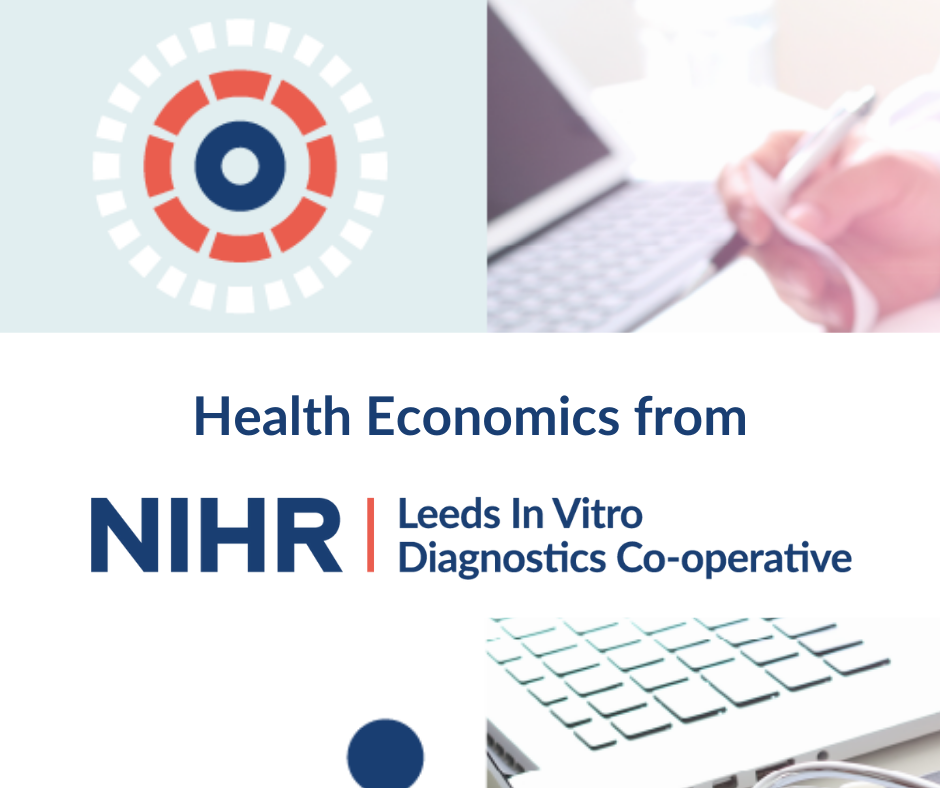The role of Health Economics in the NIHR Leeds In Vitro Diagnostics Co-operative (NIHR Leeds MIC)
The NIHR Leeds MIC is a centre of excellence that brings together patients, clinicians, researchers and industry. Each of our clinical themes (Oncology, Renal Medicine, Musculoskeletal and Infection Diagnostics) has access to cross cutting methodological expertise to evaluate in vitro diagnostics (IVDs).
Our methodological expertise includes Clinical Trials and Study Design, Multidisciplinary Pathology, Health Informatics and Health Economics. These are essential tools in the development and evaluation of IVDs, bringing benefits earlier to patients.
Health Economics is a methodology which enables you to pull all the evidence together on the health and cost implications of introducing something new to the NHS, providing information to support decisions about how the NHS budget is spent. For diagnostic tests, this often means producing or compiling data to measure the performance and healthcare resource implications of a new diagnostic pathway compared to current clinical practice. Producing key data to inform decisions in this way helps to ensure that NHS money is spent on things that are going to provide the greatest health benefits for patients.
This case study focusses on the important role that our Methodology team, led by Bethany Shinkins, played in the evaluation of point-of-care creatinine testing (performed near the site of patient care) prior to contrast-enhanced diagnostic CT imaging.
Point-of-Care Creatinine Testing
Although rare, contrast agents used to enhance CT imaging scans can cause acute kidney injury in people with poor kidney function. Consequently, current international clinical guidelines state that, prior to undergoing a contrast-enhanced CT scan, kidney function should be assessed to identify those at possible risk. The need for rapid diagnostic imaging is increasing, but the requirement for an additional laboratory blood test prior to imaging is proving highly disruptive to this pathway, resulting in wasted appointments, delays to diagnosis, and inconvenience to patients.
Bethany Shinkins, Associate Director of Methodology and Health Economics Theme Lead at the NIHR Leeds MIC explains:
“This was a fantastic collaboration, led by two pioneering radiographers (Professor Beverly Snaith and Martine Harris) from Mid Yorkshire Hospitals Trust, who had identified a bottleneck in their everyday clinical practice and had come up with a potential solution. They approached the NIHR Leeds MIC for methodological support, and we were keen to help given the real potential to quickly impact and improve clinical care. We provided statistical support, health economic analyses and vital input from our patient group”.
Meeting the Challenge
The solution had two key elements:
- to eliminate the need to do a blood test in everyone prior to contrast-enhanced CT, and
- to make point-of-care testing devices available in radiology departments to measure kidney function in those who do need testing.
A programme of research was developed assessing the feasibility of using a questionnaire to identify those who are at risk and require testing and to evaluate the performance and cost-effectiveness of point-of-care creatinine testing devices.
A three phased approach was adopted:-
Phase 1 Mapping current practice, resource use, and development of an alternative streamlined pathway.
Current clinical pathways in imaging across five different NHS trusts were mapped based on input from operational and clinical experts. Resource use was also estimated for current practice by recording how long different activities took to complete and the associated costs. An existing screening questionnaire was modified to identify those who need on-the-day creatinine testing. The feasibility of an alternative pathway using a risk-informed approach with point-of-care creatinine testing was explored.
Phase 2 Evaluating the comparative performance of three point-of-care creatinine devices
Three hundred adult patients were recruited to have additional blood samples to compare the performance of 3 CE-marked point-of-care devices against a reference laboratory standard. The accuracy of kidney function categorisation was assessed to explore the feasibility of using these devices for clinical decision making in diagnostic imaging.
Phase 3 Comparative cost evaluation.
The pathway mapping and resource use information from phase 1 was used to create a mathematical model. This model produced an assessment of the comparative costs associated with current practice and the alternative pathway. The model also allowed us to estimate how many cancelled appointments were avoided and how much radiographer time was released.
Bethany Shinkins, says:
“In addition to the cost implications of the proposed pathway, the economic modelling allowed us to look at other consequences such as the reduction in wasted appointments and clinical time released.”
Outcomes
The results of this programme of work have since been used to inform a NICE MedTech Innovation Briefing and NICE Diagnostics Guidance (DG37). This guidance recommends the use of point-of-care creatinine testing when current practice requires that kidney health is assessed prior to contrast-enhanced CT and the patient does not have a recent measure of kidney health. A risk-informed approach must be used. More recently, the published feasibility work has been cited in an American Association for Clinical Chemistry guidance document.
Bethany Shinkins continues:
“Overall, the study demonstrated that a risk-informed CT pathway including point-of-care creatinine testing is a feasible and cost-effective approach to measuring on-the-day kidney function prior to contrast-enhanced CT scans.”
This case study demonstrates the many ways that high quality methodological input can help to ensure that research impacts upon and improves clinical care within the NHS.
Bethany Shinkins concurs:
“Health economics remains essential to the NIHR Leeds MIC methodology offering to allow synthesis of available evidence, understand the healthcare resource and cost considerations and, ultimately, inform decision-making. This is just as important for tests as it would be for a treatment, given the real potential for patient harm and benefit and considerable cost implications”.


